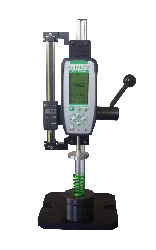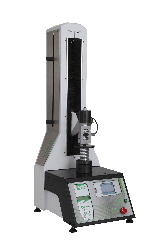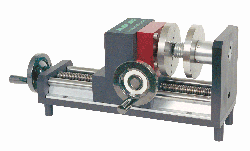

How to measure the force of a spring?
Measuring forces of springs is one of the most important test to determine the quality of the springs. Indeed all the springs are designed to have an expected force at a particular height, it is essential to validate the calculations and especially the manufacturing parameters by measuring forces. 
Most of the time, the spring is used in a mechanism that has a rest position and an operating position. We therefore define a spring in determining two operating heights, H1 and H2 and measuring the loads expected when the spring is compressed to H1 and H2. So the requested measurement is the forces at H1 and H2. For a standard spring the tolerance is 10%, it is reduced to 5% for precision springs.
Several factors will influence the quality of measurement:
The shape of the spring:
- Concentricity of coils: the axis of the spring must be centered
- The geometry of the square bearing face: particularly we get a better repeatability with a spring whose faces are flat and the last turn is contiguous.
- The height / diameter: A 'slim' spring will tend to bend during the compression (buckling). In this case, it is necessary to guide so it stays vertical. Pins are generally used for internal guidance. These pins must be carefully defined so that the friction of the spring on the rod when buckling is minimized and constant.
- The internal strain: some springs are calculated at the limit of permissible internal strain level. In this case during the first compression tests, the metal works in the plastic area and the spring relaxes a little. The values obtained during the first test will be higher than the 3rd or 4th tests. Usually it is asked to perform a set of loads on the spring (usually 5) before performing the measurement to avoid these variations.
Process parameters:
- The characteristics of the wire used can vary in the same coil but especially from one coil to another.
- The constancy of the machine settings for coiling springs.
- Constraints on the wire when forming the spring which sometimes lead to the need to 'relax' the spring before the measurement.
 Spring Tester features:
Spring Tester features:
- Geometry of the plates: the plates must have a flat surface, the two plates must be perfectly parallel.
- Sensor resolution: the characteristics of force sensors and displacement (resolution, accuracy) are key elements. For the force sensor, the accuracy required is generally 0.1% and the resolution finer than 1 / 1000.
- For the displacement sensor, a resolution of 0.01in is sufficient except in very small springs or springs with small loads. Particular attention should be paid to the accuracy of the displacement sensor in the case of large-spring stiffness, in fact in this case a small error in the measurement of displacement results in a large dispersion in the force measurement.
- The general qualities of the support frame sensor and especially its stiffness.
Frequently asked questions about the extent of spring:
What is the load cell compensation?
This term refers to an operation which corrects the error of measurement of displacement due to the deflection of the frame on the one hand and the deformation of the sensor on the other. Using a very rigid stand and high quality sensors, we can reduce this error. A well designed load cell presents an error of less than 0.005in at the full charge. However in the case of precise measurement, it may be necessary to perform this operation.
Electronic method: some electronic incorporate the correction coefficient calculated by the manufacturer. This method does not take into account the aging of the frame and the sensor.
Mechanical method: This method is to put the plates touching, apply a force equivalent the spring and reset the zero on the displacement sensor.
Should we use positioning stops to determine the heights H1 and H2?
Besides the difficulty of adjusting the position of the stops, we must not forget that the stops are mechanical dispersion related to the speed of docking or even changing the setting itself. This method is used for very important quantities or inexperienced operators. An experienced operator will obtain more consistent results and faster by using the displacement sensors. 
Some software makes the capture of force on the fly during the transition to H1 and H2 values without having to stop. It is a very effective method if the associated electronics have a high speed sampling to 'capture' force as close as possible to the desired height.
How to measure the free height?
To measure the free length in a reliable and repeatable way, we determine a minimum force to achieve and we measure the length of the spring at this force.
To avoid all problems related to measurement noise, it is recommended to set this force at least 3 times the resolution of the sensor.
 based on 1 reviews.
Write a review.
based on 1 reviews.
Write a review.




